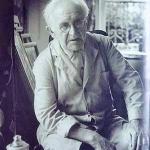
PRANAS DOMSAITIS
See all artistsBorn FRANZ DOMSCHEIT
1880 - 1965 CROPIENS LITHUANIA
Domšaitis spent his first 27 years as a farmer. Under the sponsorship of Max Liebermann he enrolled at the Royal Academy of Fine Arts in Königsberg in 1907, graduating in 1910. He then travelled and studied at various European capitals and was strongly influenced by a meeting with Edvard Munch. He befriended and travelled with the artist Fritz Ascher from Berlin who drew a portrait of him in 1919/20. He spent World War I partially on his parent's farm and partially in military service, then resumed his travels and artistic career. His successful exhibitions in Germany, Switzerland, Austria, Romania, and Turkey were disastrously followed by his inclusion in a 1937 exhibition of Degenerate art and the removal of his works from German museums. In 1938 he began signing his pictures using the Lithuanian version of his name.
In 1949,The University of Cape Town in South Africa offered his wife, the singer Adelheid Armhold a position as a senior lecturer, they decided to move and settle in Cape Town.
His youthful style has been described as romantic realism or as spiritual impressionism, his later as a melding of "...Chagall's enchanting visions, the guileless piety of Rouault, the resonant colour of the expressionists, and the intuitive wisdom of the peasant" Landscapes and village life were frequent themes, along with Christian narratives, particularly the Annunciation, the Crucifixion, and the Flight into Egypt.
Domšaitis's works are held at the Pranas Domšaitis Gallery in Klaipėda, Lithuania, the M. K. Čiurlionis National Art Museum in Kaunas, Lithuania, the Pretoria Art Museum, the National Gallery of Zimbabwe, and the National Gallery in Berlin, among others. Many of his interwar works have disappeared.
